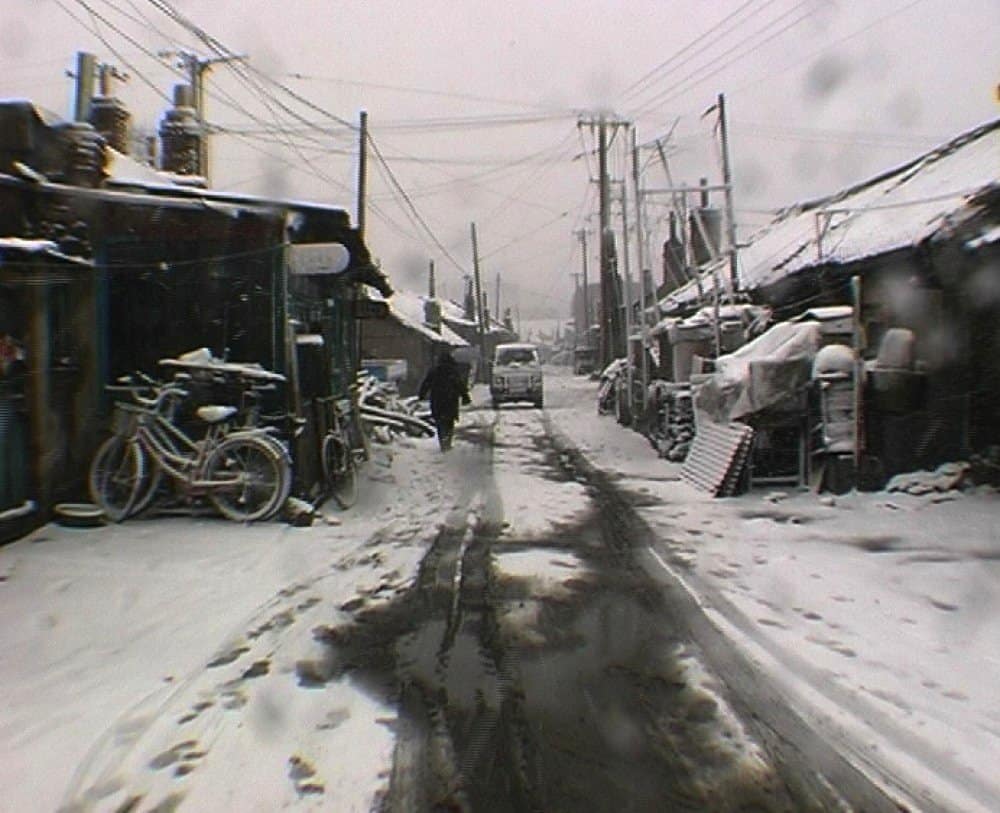Everything started in the 90s when the digital revolution and the emergence of the first camcorders coincided with the Chinese documentarians' need to record the rapidly changing post-Tiananmen reality. Wu Wenguang's “Bumming in Beijing” (1990) became the first documentary outside of the official channels in China, and the whole wave of guerilla filmmaking was to soon follow suit. Among them was “West of the Tracks” (2003), a seminal work by Wang Bing demonstrating the New Documentary Movement's artistic potential. 2023 sees Wang's two most recent films included in Cannes Film Festival's official selection, marking a watershed moment for Chinese independent documentary cinema. The recognition, unsurprisingly, was long overdue.
The clash of the modern with the traditional, the main topic of 6th Generation's filmmakers, represented by the likes of Wang Xiaoshuai and Jia Zhangke, captivated the international festival audiences. Yet, the grimy and unglamorous works of their non-fiction colleagues never achieved the same level of recognition. The New Documentary and underground narrative filmmaking had a large overlap, and it is also worth remembering that Jia, among others, started his career in documentary. Despite this, the career of the director of “A Touch of Sin” took off internationally, whereas his documentarian colleagues received little recognition over the years. Ai Weiwei is the only exception to this trend; however his activist and participatory cinema should fall into a completely different category.
Shot often singlehandedly, or with a minimal crew; recorded clandestinely and comprising of scattered found footage; focusing on the social underbelly, outcasts, criminals and cripples, the Chinese indie docs had to develop in one of the least favourable environments in the world. In their depiction of rapidly changing Chinese society, the works were too problematic for the government. The directors would therefore not even attempt going through the CCP's censorship process, with their films thus being condemned to a limited distribution internationally.

With scarce domestic exhibition possibilities, directors such as Xu Tong, Gu Tao or Hu Jie either uploaded their works online, smuggled them to Western film festivals or art galleries. A recent program, presented by Berlin's Sinema Transtopia and curated by Tang Xuedan, contributed to bringing forward the documentary works otherwise largely neglected by both domestic and international audiences. “From the margins of China: An exploration of uncelebrated narratives from contemporary China” put unusual perspectives in the spotlight, highlighting the vast potential of Chinese cinema, beyond the huge budget productions. It also harkens back to Bérénice Reynaud's contention that one of the main goals of Chinese indie documentaries was an escape from “a teleological and Han-centred history of China as rewritten by Maoism”. Spaces, and their reinterpretations, were the emerging theme of the selected works.
Marginal Space
The films presented highlighted the sidelined perspectives of ethnic minorities in the PRC. Han Chinese are making up 91% of PRC's population, but other ethnicities and nationalities remain vastly underrepresented in official culture. This is most overtly visible by the controversies surrounding human rights violations of the Uyghur Muslim minority in Xinjiang. Years before the BBC investigations and human rights scandal, an independent filmmaker had managed to capture the different complexion of the ethnic discrimination directed at the Uyghurs. “The trial from Xinjiang” (2010) is Chen Dongnan's directorial debut. The taboo-breaking work focuses on the phenomena that remain largely unacknowledged by the Party by following three vagrant young men. Uprooted from Xinjiang and forced to work as pickpockets in various cities of China, they are victims and perpetrators of the Chinese organized crime. Raised by the street, or bought as children from their families to work for criminal bosses as thieves, they have no say in their fates. What follows on screen is their gradual spiral into addiction, alienation from friends and family, and ultimately, lives of total outcasts. Chen's documentary provides an insight into the ethnic dynamics and tensions by illustrating how the minorities are stereotyped, abused and alienated within the mainland China.
Check also this article
“Xiaohui and his Cows”, a short by a film student Lao Xinying, plays with the magical realism conventions in order to show the world out of balance. The protagonist is a schoolboy who lives with his grandfather and their cows. His parents are gone to the city, where they slave themselves off, and cannot return home because of the covid-19 regulations. Xiaohui, effectively an orphan, tries to save the cows from being sold to the slaughterhouse. The film illustrates the atomization of nuclear families due to labour movements: domestic migration for work is one of the phenomena most severely impacting the minorities living on the peripheries of the country. “Xiaohui…” expresses concern in line with many works of the aforementioned 6th gen filmmakers: the Party's attempts at modernizing the country take a toll on more traditional ways of life and old social arrangements. Xiaohui's rebellion, or a cry for help, is demonstrated by him stealing the cows and escaping with them to the woods, in a futile attempt to break the dysfunctional cycle. The film, closing with an image of cows on a back of the truck, on their way to their industrial demise, paints a grim image of the things to come.
“The Last Moose of Ao Lu Gu Ya” (2013) looks at the evaporating culture and the way of life of the Ewenki minority. The protagonist, Weijia, is a reindeer hunter, and an alcoholic. Both aspects of his life are equally important, as they blend seamlessly together. Weijia appears to be always drunk, and always on the hunt (although reindeers are not always the hunted objects, a bottle of liquor often being a more desired target). The film is Gu Tao's exercise in patience and commitment. Shot over a period of five years in remote forests, often completely snowed in and detached, “The Last Moose…” sticks closely to the verité tradition which largely influenced Chinese indie documentaries. The director captures the actuality of Weijia's existence against the backdrop of a larger transformation of the region enacted by the government. Cabins and tents are replaced by barracks, while the forests are also gradually wiped out. The change takes a toll on the community of the Ewenki, whose customs become redundant in the face of comfortable modernization. A brief episode sees Weijia move to the city with a partner, and try to adapt to the new reality. Unable to fit in, and fight his alcoholism, the protagonist falls into a lethargic state. The story abruptly jumps some months forward, with the reason for the ellipsis being Weijia's episode in a psychiatric asylum.

In the film's most memorable scene, the protagonist brings various offering to the grave of his family member, hidden deep in the woods. A long medium shot records Weijia as he tries to open a jar of pickles, but unable to do so, he keeps smashing his fist into it. Resigned, he takes another jar and smashes the two against each other. Bits of the containers' contents actually stick to the camera's lens, and remain on it in the following scenes, adding an almost tactile element to the image. The comedic scene captures the essence of Weijia's conundrum: equipped only with simple tools and brute force, he is unable to take on the challenges modernity throws at him. After the pickles are smashed, Weijia proceeds to open a bottle of liquor. Will he pour everything on the grave, or will he have a drink himself? We all know the answer, because by that time Gu Tao makes it clear, that for his protagonist, alcohol is often the only answer to the encountered problems. Living on the physical fringe of the country, he seemed comically detached from the neoliberal revolution happening in the PRC. Living a practically nomad life, Weijia was a figure out of time – that is, until the integration policies and state-enacted modernization turned up at his doorstep.
















